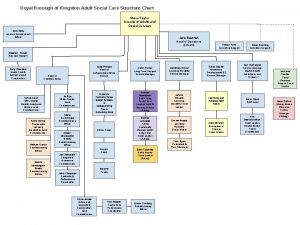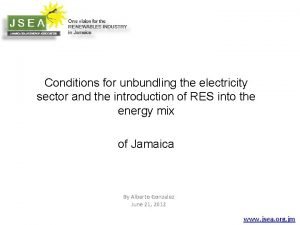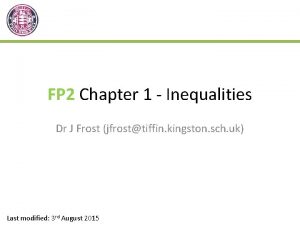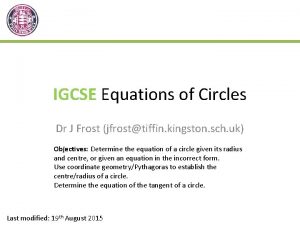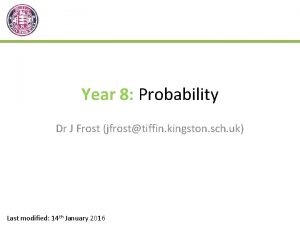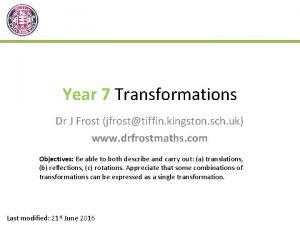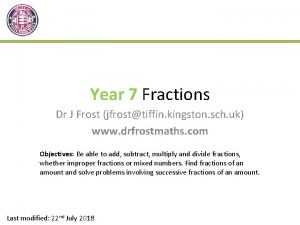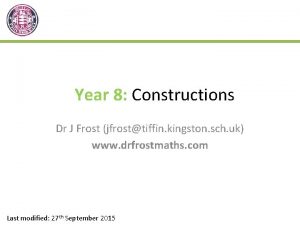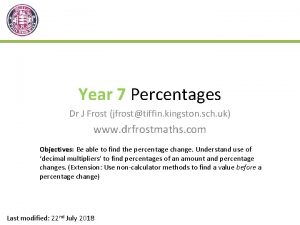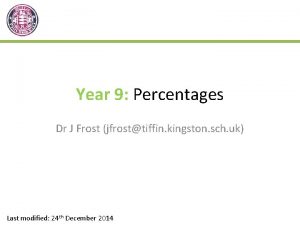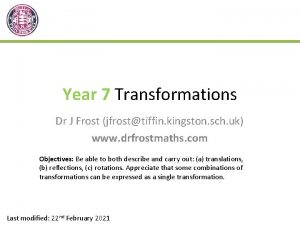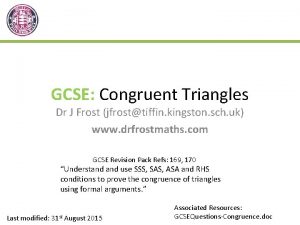Year 9 Inequalities Dr J Frost jfrosttiffin kingston






















- Slides: 22

Year 9 Inequalities Dr J Frost (jfrost@tiffin. kingston. sch. uk) Objectives: Solving linear inequalities, combining inequalities and representing solutions on number lines. Last modified: 23 rd March 2015

Writing inequalities and drawing number lines You need to be able to sketch equalities and strict inequalities on a number line. This is known as a ‘strict’ inequality. x>3 Means: x is (strictly) greater ? than 3. 0 1 2 3 4 x < -1 Means: x is (strictly) less? than -1. 5 -3 -2 -1 ? 4 5 ? 2 x≤ 5 Means: x is greater than? or equal to 4. 3 1 ? x≥ 4 2 0 6 7 Means: x is less than or ? equal to 4. 2 3 4 5 ? 6 7

Deal or No Deal? We can manipulate inequalities in various ways, but which of these are allowed and not allowed? Can we add or subtract to both sides? Click to Deal Click to No Deal

Deal or No Deal? We can manipulate inequalities in various ways, but which of these are allowed and not allowed? Can we divide both sides by a positive number? Click to Deal Click to No Deal

Deal or No Deal? We can manipulate inequalities in various ways, but which of these are allowed and not allowed? Can we multiply both sides by a positive number? Click to Deal Click to No Deal

Deal or No Deal? We can manipulate inequalities in various ways, but which of these are allowed and not allowed? Can we multiply both sides by a negative number? Click to Deal Click to No Deal

‘Flipping’ the inequality If we multiply or divide both sides of the inequality by a negative number, the inequality ‘flips’! OMG magic! -2 2 < -4 4 Click to start Bro-manimation

Alternative Approach Or you could simply avoid dividing by a negative number at all by moving the variable to the side that is positive. ? ? ? ?

Quickfire Examples Solve Solve ? ? ?

Deal or No Deal? We can manipulate inequalities in various ways, but which of these are allowed and not allowed? Can we multiply both sides by a variable? Click to Deal Click to No Deal The problem is, we don’t know if the variable has a positive or negative value, so negative solutions would flip it and positive ones wouldn’t. You won’t have to solve questions like this until Further Maths A Level!

More Examples Hint: Do the addition/subtraction before you do the multiplication/division. Solve ? Solve ? ?

Dealing with multiple inequalities Hint: Do the addition/subtraction before you do the multiplication/division. 8 < 5 x 5 x -- 22 ≤ 23 and 2 < x and x ≤ 5 Click to start bromanimation

More Examples Hint: Do the addition/subtraction before you do the multiplication/division. Solve ? ?

Test Your Understanding Solve ? ?

Exercise 1 Solve the following inequalities, and illustrate each on a number line: 1 2 3 4 ? ? 5 ? 6 ? ? ? 7 8 9 10 11 N 1 ? N 2 ? ?

Combining inequalities It’s absolutely crucial that you distinguish between the words ‘and’ and ‘or’ when constraining the values of a variable. AND How would we express “x is greater than or equal to 2, and less than 4”? ? x<4 x ≥ 2 and x ≥ 2, ? x < 4 2 ≤ x? < 4 This last one emphasises the fact that x is between 2 and 4. OR How would we express “x is less than -1, or greater than 3”? ? x>3 x < -1 or This is the only way you would write this – you must use the word ‘or’.

Combining inequalities It’s absolutely crucial that you distinguish between the words ‘and’ and ‘or’ when constraining the values of a variable. x < -1 or x > 4 2≤x<4 0 1 2 3 ? 4 5 -1 0 1 2 ? 3 4

Combining inequalities It’s absolutely crucial that you distinguish between the words ‘and’ and ‘or’ when constraining the values of a variable. To illustrate the difference, what happens when we switch them? or and x < -1 or x > 4 x ≥ 2 and x < 4 0 1 2 3 ? 4 5 -1 0 1 2 ? 3 4

I will shoot you if I see any of these… This is technically equivalent to: x<4 ? This is technically equivalent to: x>7 ? The least offensive of the three, but should be written: 4<x<7 ?

Combining Inequalities In general, we can combine inequalities either by common sense, or using number lines. . . 2 5 Where are you on both lines? 4 Combined ? 2 5 4 Combined ?

Test Your Understanding ? 1 st 2 nd -1 condition Combined -3 ? ? 5

Exercise 2 By sketching the number lines or otherwise, combine the following inequalities. 1 2 3 4 5 6 7 8 9 10 11 12 13 14 15 ? ? ? ? ? ? ?
 Kingston strategic partnership
Kingston strategic partnership Adult social care kingston
Adult social care kingston Kingston na jachcie
Kingston na jachcie Fass loans kingston
Fass loans kingston Kingston traffic report
Kingston traffic report On discovery maxine hong kingston
On discovery maxine hong kingston Kingston planning scheme
Kingston planning scheme Margaret kingston manchester
Margaret kingston manchester Martin kingston qc
Martin kingston qc Aquajet kingston
Aquajet kingston Jps ecommerce kingston 5
Jps ecommerce kingston 5 Dr frost inequalities
Dr frost inequalities Similar shapes dr frost
Similar shapes dr frost Quadratic inequalities dr frost
Quadratic inequalities dr frost School leavers poems
School leavers poems Dr frost vectors
Dr frost vectors Personification in the road not taken
Personification in the road not taken Equation of a circle dr frost
Equation of a circle dr frost Dr frost compound measures
Dr frost compound measures Dr frost probability
Dr frost probability Poetry is what gets lost in translation
Poetry is what gets lost in translation Father frost slovenia
Father frost slovenia Metaphor nothing gold can stay
Metaphor nothing gold can stay

